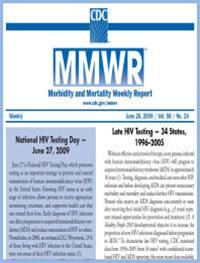This article discusses the problem of late HIV testing in the United States and emphasizes the importance of HIV testing, diagnosis, and treatment, soon after HIV infection and before developing AIDS, to prevent more severe illness and death and reduce HIV transmission. Findings are reported from a study in which CDC analyzed data from 1996 - 2005 from 34 states with confidential name-based reporting to determine the percentage of persons who received an AIDS diagnosis less than or equal to 3 years after receiving an HIV diagnosis. Findings show that within 1 year, 38.3% had received an AIDS diagnosis; another 6,7% had an AIDS diagnosis from 1 to 3 years after their initial HIV diagnosis. Results are further analyzed by race/ethnicity, sex, and HIV transmission category. Compared to Whites, greater percentages of persons in other racial/ethnic populations received an AIDS diagnosis within three years of their initial HIV diagnosis. Also, men were more likely than women, and older persons were more likely than younger to be diagnosed with AIDS at three years after initial diagnosis.
Format:
Report
Publication Date:
2009
ID:
34662
- HIV and AIDS
- HIV Testing


